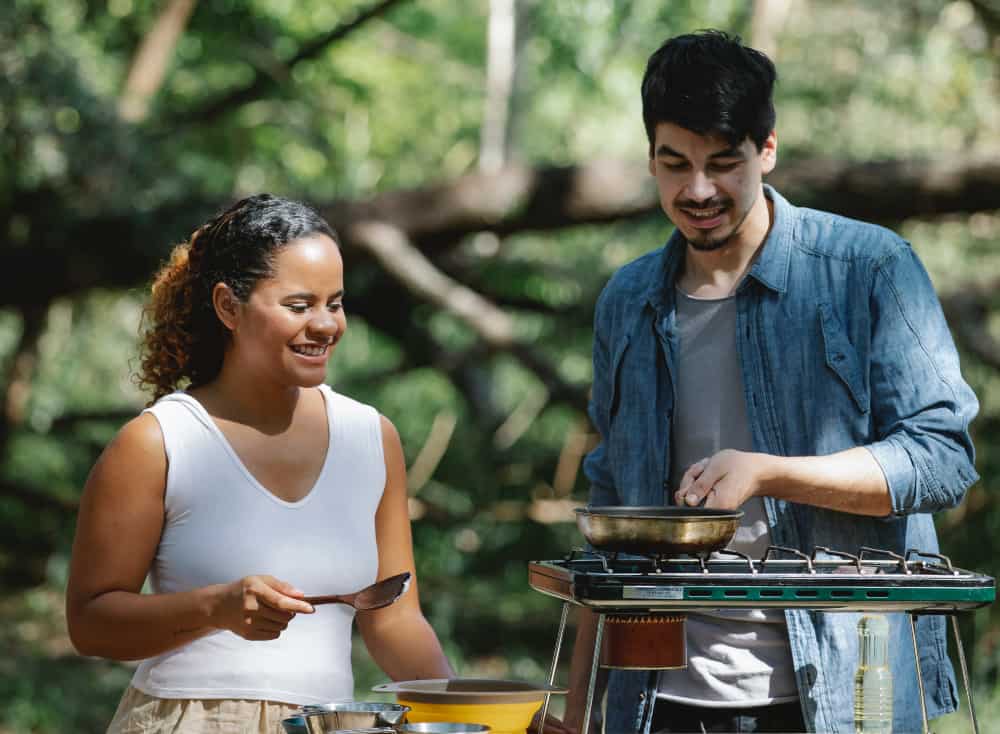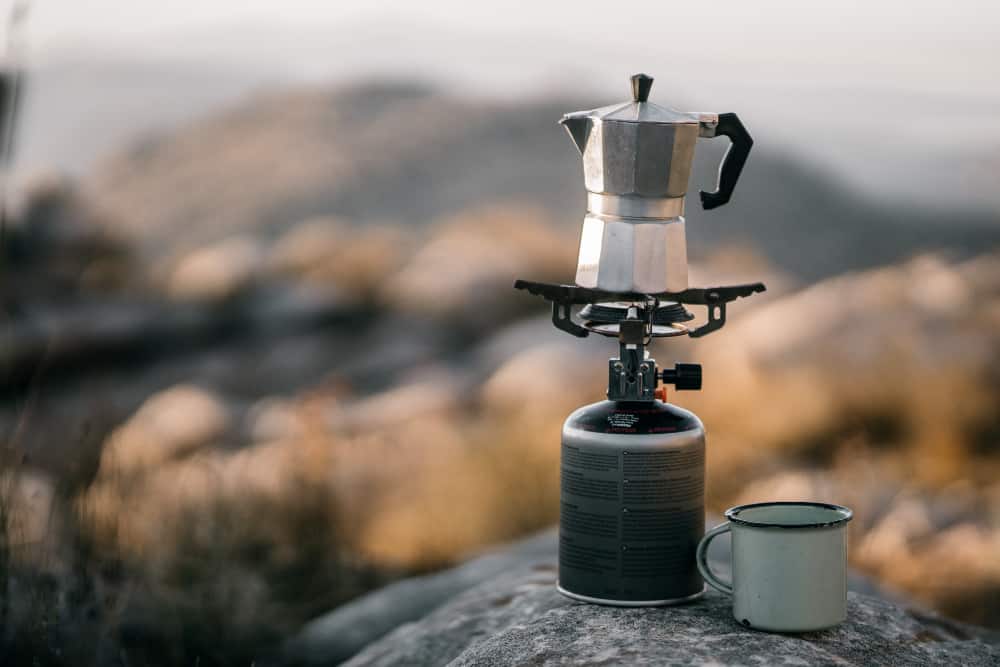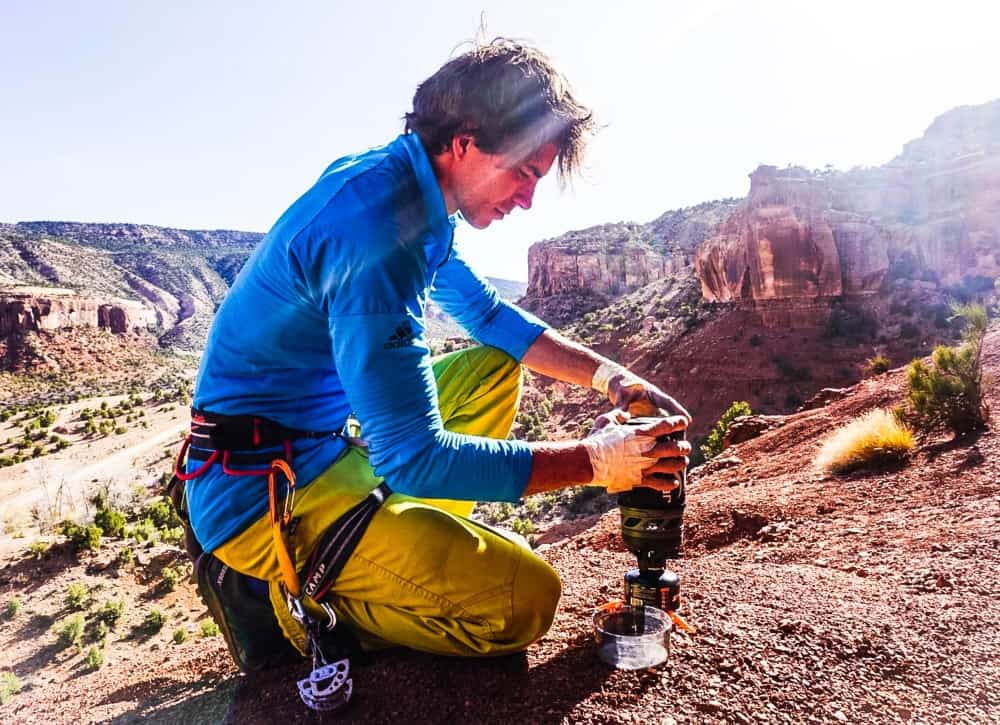Campfires are being swept into history due to safety issues. In addition, droughts and hotter summer temperatures are drying out forests, raising the fire risk. Thus, the popularity of camp stoves is on the rise.
But buyers must decide if their camping style requires a good butane or propane stove. The age old question of butane vs propane camp stove. Yes, there is a difference.
Butane and propane are popular fuels for camping stoves. Which type of camping stove is best depends on your needs. Propane is easiest to source, has a lower vapor pressure, and is typically cheaper. However, butane has a higher liquid density, making it lighter to haul and perfect for backpackers.
If you’ve ever camped with a chemical engineer, then phrases such as “lower vapor pressure” and “higher liquid density” are familiar. But to everyone else, it is mindboggling confusion. But these complicated details matter if you camp in cold conditions or must haul all your camping gear on your back.

Butane Camp Stoves: Pros and Cons
Butane stoves run on the same fuel found in most cigarette lighters. The flammable, colorless, and nearly odorless gas is derived from crude oil and has a higher liquid density than propane.
In simple English: it’s easy to turn butane gas into a liquid and keep it in that fluid state. Thus, butane does not require highly sophisticated and pressurized containers.
Butane’s easy-going liquid nature is why it is prevalent in cigarette lighters. The lack of packaging required makes cigarette lighters significantly lighter than if they were filled with propane.
In camping terms, it is much lighter to haul butane than to transport propane. Hence, if you are a backpacker where every ounce matters, butane is the clear winner.
That is unless you are a true mountaineer with the hide of a polar bear. Then butane could be the clear loser. One massive drawback to butane is its freezing point when kept in a liquid state. It essentially freezes at 32F (0C).
Butane’s ability to freeze is how you get stories of backpackers sleeping with their stove canisters when the weather unexpectedly shifts to freezing. Then, during the day, the long-haul hikers stick the canisters inside their coats.
Thankfully, there is an alternative to butane that can help backpackers out. But it isn’t propane.
Isobutane: Alternative Camping Fuel For Backpackers
Cold weather backpackers can often avoid lugging propane by using isobutane. Isobutane is another colorless gas that can easily be kept in a liquid state.
But even better, the flammable fuel handles cold temperatures better than butane, doing well in temperatures as low as 14F (-10C). Thus, it is a lightweight fuel that typically works with butane stoves (always check before using).
However, isobutane does have some drawbacks. First, it is typically more challenging to find than butane and propane. It usually costs more than butane and propane. Lastly, it has a smell. It isn’t awful, but it is present and can irritate the nose and lungs.
Thus, isobutane should not be used indoors, including in your tent. (Some campers do this anyway and then wonder why they have a headache. Just don’t.)

Propane Camp Stoves: Pros and Cons
The most popular camp stove fuel in the United States is propane. Pushing the chemical engineer speak aside, this flammable fuel is basically liquid petroleum gas. It is colorless and non-toxic, so you can burn it indoors.
Propane technically has no odor, but a scent is commonly added for safety reasons in the event an unlit stove is left on while indoors. The smell is supposed to alert you to a gas leak before you die.
The fuel has two significant positives: it’s easy to source and almost always costs less than butane or isobutane. These positives owe much to its prevalence in the restaurant industry and homes.
Hence, campers don’t have to hunt down a sporting goods store to refuel their propane canisters or tanks but can often do it at their local gas station.
Propane’s third superpower is that a propane stove can work in very low temperatures. It keeps chugging until about -42 to -44F (-42C). For those winter RV campers, this detail is crucial to enjoying a hot breakfast.
However, propane needs a lot of pressure to keep it in a liquid state. It works out to about three times more pressure than butane requires.
To ensure propane stays in its fluid form, its canisters are thick, which causes them to weigh a significant amount. This is why such a lightweight fuel is so heavy to transport. It isn’t the actual fuel that’s the problem, but the specialized canisters.
Can I Use LPG In My Propane Stove?
LPG is an ambiguous term and thus can mean different things. The acronym stands for Liquid Petroleum Gas. In the United States, it is almost always synonymous with propane. Therefore, LPG and propane are the same in the US and will work perfectly in a propane stove.
However, in the rest of the world, LPG might contain as little as 20% propane and have as much as 80% butane. It still works if the LPG canister connector fits your stove. But you might discover you need to adjust the regulator a bit differently to account for the different burn rates.
But if you are camping in high altitudes or below freezing temperatures, then the high butane content of your LPG could give you some problems. So, if you are camping at a high altitude outside of the US, pay attention to the mixes of any LPG you buy. Otherwise, you might be hauling fuel that’s worthless.
Can I Use Propane In My Butane Stove?
Do not use propane in a butane stove. This is highly dangerous and could end badly. Some stoves can burn practically any kind of fuel you throw at them. But if you own a butane-only stove, your only other safe option is probably isobutane.
The problem with putting propane in a butane stove is the air mixture. Butane stoves mix the fuel with a certain amount of air. When you add a butane quantity of air to propane, you end up with a yellow flame. Which sounds cool, but it could wreck your stove.
While ruining your camping stove is a bummer, it’s still not as bad as asphyxiating yourself, which is another potential disaster.
Butane stoves shouldn’t be used indoors in the first place, but when you use propane with them, it is truly a death waiting to happen. The flame isn’t burning right, so you are setting yourself up for carbon monoxide poisoning.
Have people used propane in a butane stove and suffered no consequences? Yes. But people have also played Russian Roulette and lived to tell the tale. So just don’t do it.

What Kind Of Camping Fuel Does A Jetboil Use?
Jetboil camping stoves are fantastic buys. The company sells canisters made of an isobutane and propane mix.
Thus, they combine the lightweight features of isobutane while providing a lower freezing temperature thanks to the propane. This allows the canisters to remain backpacker-friendly while delivering the “four-season” fuel advantage.
While Jetboil fans don’t have to use the company’s fuel, they are limited to canisters with an EN417 nozzle. The nozzle is essential for proper attachment to the stove.
Generally, the EN417 canisters will be an isobutane/propane mix or a butane/propane mix. The ratios might differ from Jetboil’s combo, but the stoves will operate satisfactorily.
More info: Check out our guide on which fuel to use with Jetboil camping stoves.
Are There Camp Stoves That Can Use Propane or Butane?
There are multi-fuel camp stoves on the market. However, they are typically much more expensive, harder to operate, potentially heavier to carry, and can be pretty high maintenance, including requiring meticulous cleaning.
However, these things can be lifesavers if you are a hard-core backpacker who ventures into various countries and pass-through remote communities with limited supplies.
The top-quality multi-fuel stoves can burn kerosene and unleaded gas, and some can even handle diesel (yes, burning diesel smells as bad as you think it does).
These stoves are not made to create high-quality camp cuisine. Instead, they have the subtly of a blowtorch. There is technically an adjustment level, which typically includes: off, on, and a mythical setting in-between. Thus, they are perfect for boiling water and turning food into pure carbon.
Here are three top-quality multi-fuel camp stove options.
MSR Dragonfly: A Multi-fuel Camp Stove
The MSR Dragonfly can burn almost anything: white gas, kerosene, diesel, unleaded gas (petrol), and even jet fuel.
MSR WhisperLite Unviersal: A Multifuel Camp Stove
The MSR WhisperLite is a compact version of the Dragonfly. It does not burn diesel. However, it can handle unleaded, along with butane, isobutane, propane, and kerosene.
It doesn’t look like much, but we have friends who are still using theirs after two decades. That thing has been dragged up and down the Rockies, across Europe, and through Southern Africa, and it still won’t die.
Vargo Triad: A Multi-Fuel Camp Stove
The Vargo Triad looks like a tiny alien spaceship constructed out of titanium. It weighs .1 pounds. It burns alcohol, solid fuel tabs, and gels. It’s like using a tea light that gained superpowers.
